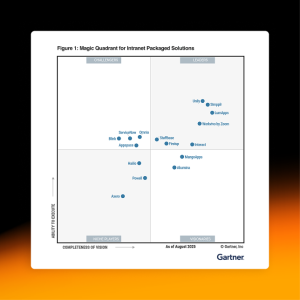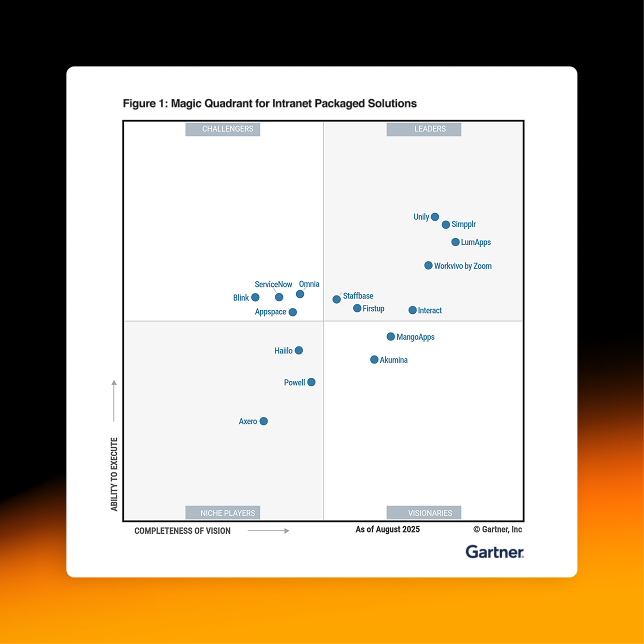Simpplr Research has been conducting a series of research and analysis for over a year. As a result, we’re sitting on hoards of fascinating data that we’re eager to share. We’re excited to introduce our new series: Chart of the Week. Every week, we will be sharing unique insights based on what we’ve learned thus far to improve internal communications and help connect distributed organizations.
Simpplr Research reveals the correlation between Glassdoor ratings and stock market performance
Last year, Simpplr Research conducted the research study: Glassdoor Data on Employee Communication & Retention. The report concluded that alignment, purpose, and community are critical drivers of overall Glassdoor ratings. These attributes mattered more than autonomy, development, manager appreciation, compensation, benefits, and many other factors.
A year has passed since this analysis and since we spent so much time logging Glassdoor scores across companies in the Wilshire 5000, we thought it would be interesting to see how the stock has since performed based on the leaders and laggards in our dataset.
The premise is:
If culture really matters, there should be some benefits to business performance.
Admittedly, this isn’t Simpplr Research’s most rigid analysis:
- The timeframe is random over 14 months
- Not every Wilshire 5000 company had Glassdoor reviews a year ago
- Did not control for companies with a low Glassdoor sample size
- Used June data to mitigate the recent market volatility from tariff squabbles
With that said, please use this data directionally. For a more in-depth analysis, Glassdoor’s research team does a great job evaluating financial impact. Nonetheless, our analysis is from thousands of companies and multitudes more reviews.
Furthermore, we fully appreciate the chicken or egg conundrum you’re about to examine. Is culture terrible because the company’s outlook is gloomy? Or is a bad culture driving poor performance results? We can’t answer that today. Nonetheless, the evidence overwhelmingly shows that stock performance from Glassdoor leaders (i.e., companies with superior culture) significantly outperform the laggards. So regardless, if you find your organization has a bad company culture, low employee engagement, and below-average Glassdoor scores—you better be doing something to address the issues.
We tracked a year’s worth of stock performance with three components of last year’s dataset:
- Glassdoor leaders and laggards, tracked by Glassdoor’s overall score in February 2018
- Companies with high and low ratings against Glassdoor’s “senior management” attribute
- Leaders and laggards based on “company cultures and values” rating
Glassdoor leaders and laggards: Stock price growth by overall Glassdoor rating
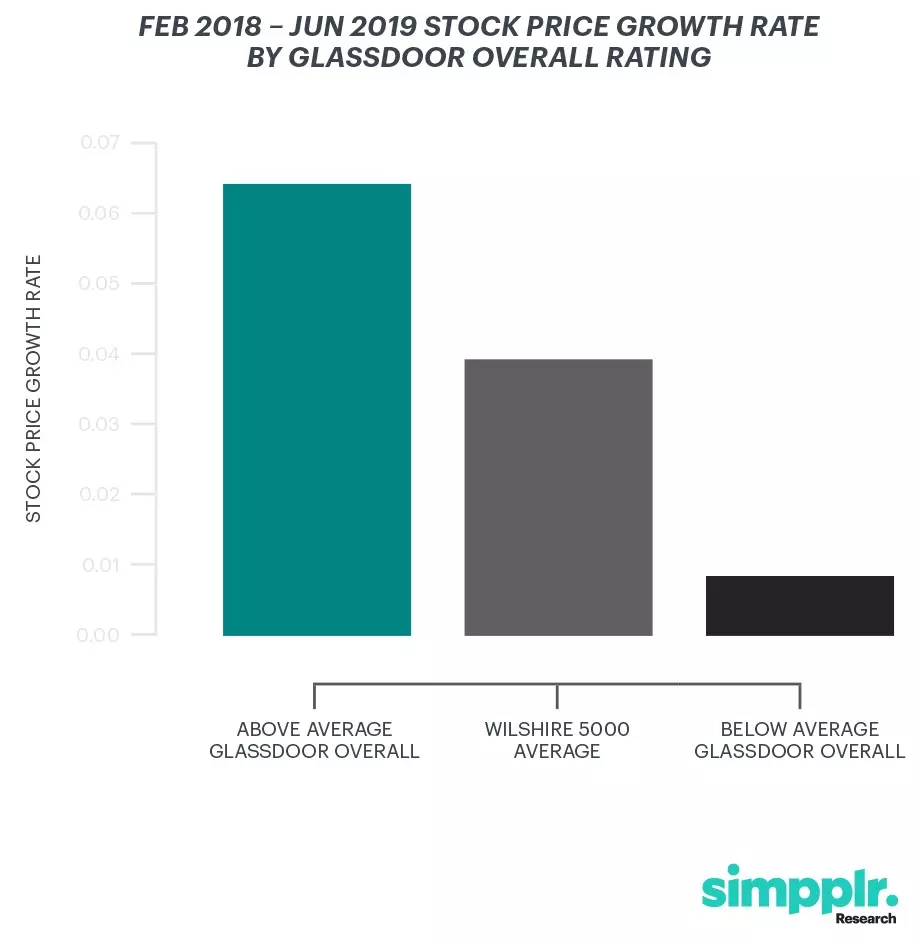
Data Analysis: The above charts use data collected from the Nasdaq website and Glassdoor.com. Stock information and Glassdoor ratings were pulled from these websites for each company in the Wilshire 5000. Between the two datasets, Simpplr Research was able to match data for over 2,000 of the companies in the Wilshire 5000. Displayed above are the average single-year stock price growth rates (Feb 2018 – June 2019) broken out by various Glassdoor ratings. The top-left chart shows the 2018-2019 stock growth for companies that had an above-average and below-average Glassdoor Overall rating. For companies with an above-average Glassdoor Overall rating, stock prices grew by over 6% on average, whereas companies with a below-average Glassdoor Overall rating, stock prices increased by a little less than 1%. A two-sided t-test of means shows that this difference is significant at the 0.01 alpha level, suggesting that these results could not have been observed by chance. The large sample gives these results reliable statistical power, and indeed, upon conducting a two-sided t-test of means with heteroskedasticity robust errors, we find that these groups are different at the 0.01 alpha level. This makes it unlikely that the results seen are spurious.
Simpplr Research has conducted further research and is now showing companies with strong Glassdoor ratings (above 4 on a 5-point scale) perform better. In the chart above, you’ll see that companies with an above-average overall Glassdoor rating experience a much higher stock increase, growing over 6% on average. On the other hand, companies with below-average overall Glassdoor ratings (below 3 on a 5-point scale) tend to increase at a much slower pace, with an average increase in stock prices by a little less than 1%. Both leading and lagging organizations are benchmarked against the average growth of Wilshire 5000 companies.
This data suggests that culture matters internally and externally – both for employees and shareholders. Since Glassdoor ratings are a reflection of the company culture, they impact an organization’s ability to attract new talent and retain employees. Employees care about company culture because it’s what facilitates employee happiness. Moreover, happier employees mean lower turnover, more productivity, increased creativity, and dedication, which leads to lower turnover and better company performance.
When employees perform optimally, the overall company performance increases, leading to higher productivity that ultimately impacts the bottom line. Business Roundtable recently published an article summarizing Fortune 500 companies aren’t focusing only on the bottom line and short term growth anymore; instead, they are focusing on promoting employee and long-term growth. The report supports long-term growth is contingent on sustained overall company performance. Again, Glassdoor has previously researched the impact of overall company ratings on the stock market, and all of this data is publically available on Glassdoor and NASDAQ.
Although we can’t confirm which way causality goes, we can say with confidence that culture is one of the most significant drivers of employee engagement and retention.
Glassdoor leaders and laggards: Stock price growth by Senior Management rating
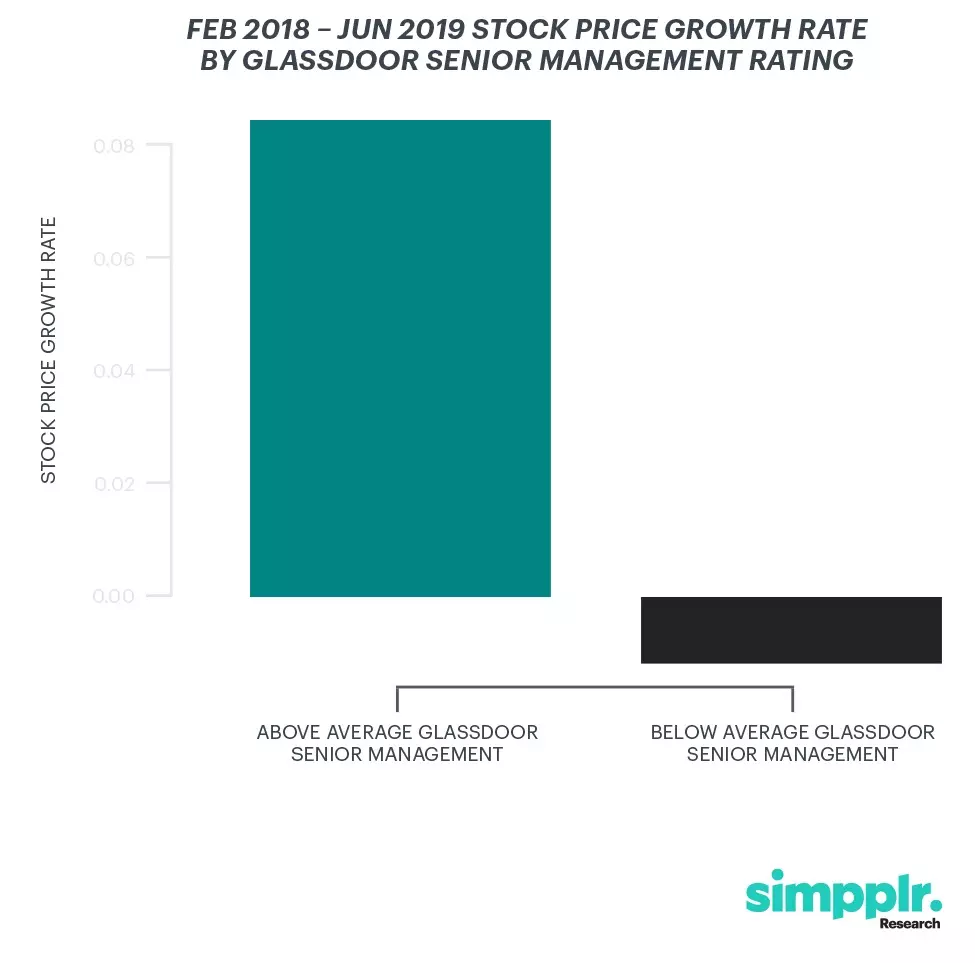
Data Analysis: The chart above adopts the same approach to the method described in the first chart. In this chart, we applied the same approach to Senior Management ratings. The top-right chart shows that at leaders in Glassdoor Senior management rating, stock prices grew by over 8% on average between 2018 and 2019, whereas at laggards, stock prices fell slightly.
Similar to the Stock price growth by overall Glassdoor rating chart above, Simpplr research isolated a specific variable, “senior management ratings” and analyzed that against the average single-year stock price growth. The results aren’t surprising. Based on the report Simpplr Research conducted last year, we know that senior management is a leading contributor to culture. Management and culture ratings always have a high r-squared in these studies, meaning employees usually rank management and culture the same. If senior management ratings are up, then culture should also increase with both ratings contributing to an increase in overall Glassdoor ratings. This data demonstrates this relationship: organizations with highly-rated senior management had a rise of over 8% on average in stock prices compared to organizations with lowly-rated senior management experienced a decrease in stock price. These figures demonstrate how critical senior management’s impact is on the bottom line. If you were to start somewhere, the Simpplr Research suggests you should begin with your senior leadership.
Glassdoor leaders and laggards: Stock price growth by Culture and Values rating
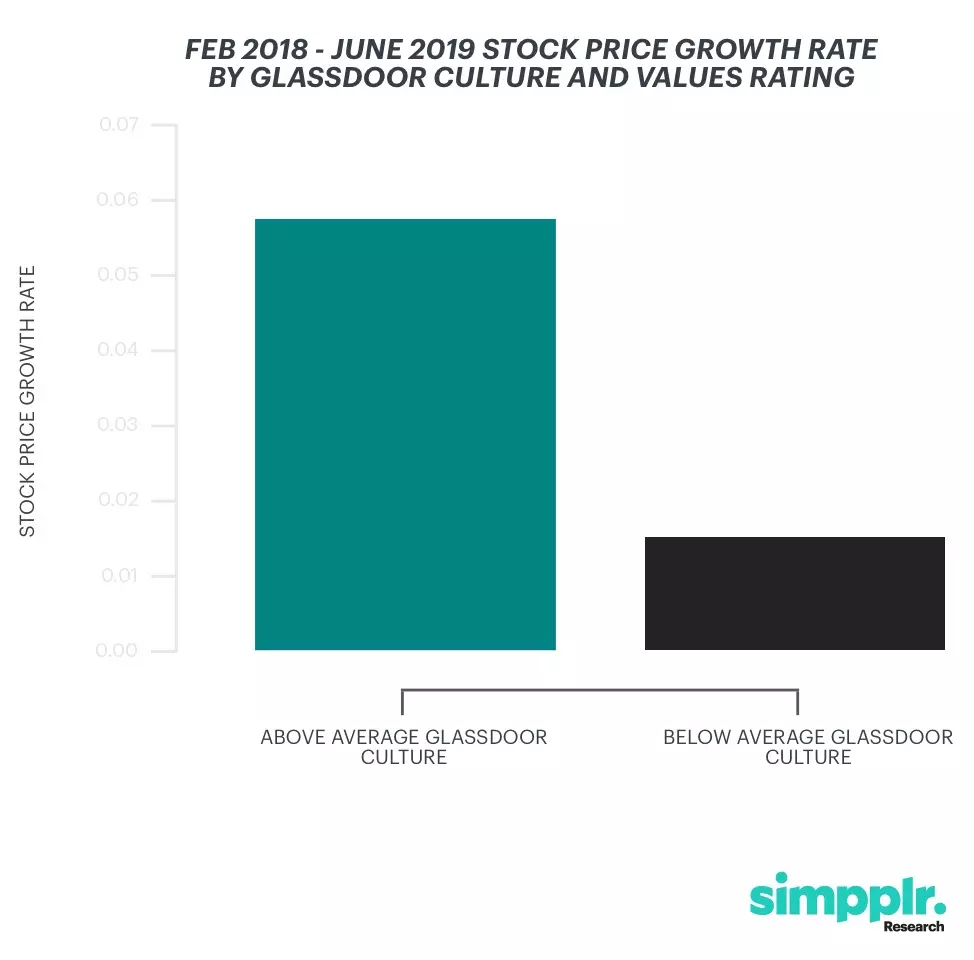
Data Analysis: Again, we applied the same method to analyze the data from Glassdoor.com and NASAQ.com. In this context, we analyzed the average single-year stock growth relative to the Culture and Ratings data based on Glassdoor. Similar to the first chart, organizations with leading Glassdoor Culture and Values rating had on average an increase of 6% in stock prices whereas organizations with lagging Culture and Values rating had an overage an increase of only 1.5% in stock prices.
There is a clear pattern in our analyses. This last chart continues to validate the high correlation between overall Glassdoor ratings and stock price growth. In this chart, we isolated the “culture and values” rating from Glassdoor data. Earlier, we hypothesized that overall Glassdoor ratings are a reflection of company culture. After analyzing the “culture and values” rating and overlaying it against stock price growth, we can further substantiate that statement. The chart above illustrates that organizations with high ratings of culture and values have an average increase of 6% in stock prices. In contrast, organizations with low ratings of culture and values only had an average 1.5 % rise in stock prices. These figures strongly suggest that an organization’s culture and values directly impact the overall performance of the company, as demonstrated in the stock price value.
Is culture the chicken or the egg?
All of these charts exhibit the impact and the relationship between culture on an organization’s performance. This analysis validates our original premise: If culture really matters, there should be some benefits to business performance. The three charts presented above strengthen our hypothesis:
- Companies with an above-average overall Glassdoor rating experience a rise in stock prices > 6% on average, compared to organizations with below-average overall Glassdoor ratings only increase in stock prices by a <1%.
- Organizations with highly-rated senior management had an increase in stock prices >8% on average, compared to organizations with lowly-rated senior management that actually experienced a decrease in stock prices growth.
- Companies that rated highly in culture and values saw an average increase of 6% in stock prices, compared to companies that rated low in of culture and values only saw an average of 1.5 % rise in stock prices.
Yes, the chicken or egg conundrum still exists. Is a lousy culture leading to poor performance results? Or is culture terrible because of the company’s dismal outlook? It’s a question that is hard to answer because we don’t know which comes first. However, we do know that all of these variables are directly related to the overall company performance as proven in the stock prices and stock price growth.
So net-net: If you’re looking to make a direct and strategic impact on your organization as an internal communicator, this is the perfect place to start. Be sure to share this with your team so you can begin to align your company priorities. And if your organization is lagging – do something!



